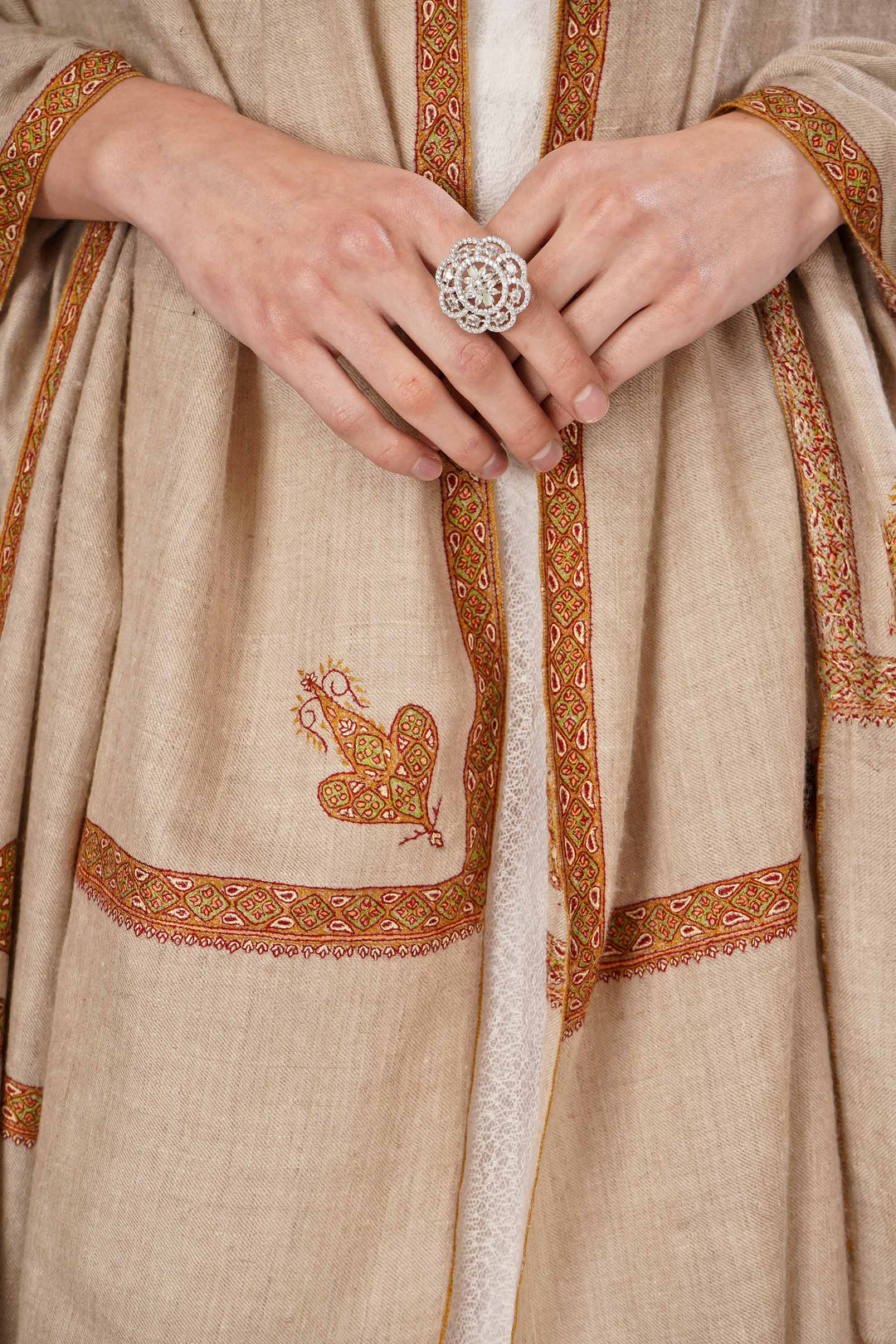what is kani shawl ? how is kani shawl made ?
The Kani Shawl — often called the Pashmina Kani Shawl — is one of Kashmir's most treasured weaving traditions, admired globally for its intricate motifs, royal legacy, and timeless artistry.
This article is curated by Kepra, a heritage Kashmiri brand with over 81+ years of experience in authentic GI-certified Pashmina. As a family of weavers rooted in Srinagar, we bring you insights into the history, making, and uniqueness of the original Kani Shawl, while also helping you understand what sets an authentic handwoven piece apart from imitations.
History of the Kashmiri Kani Shawl
The legacy of Kani shawls can be traced as far back as the 15th century when Kashmiri weavers began experimenting with fine wool weaving techniques. However, it was under the grandeur of the Mughal Empire (16th–19th century) that the Kani Jamawar shawl rose to prominence, adorning emperors, nobles, and aristocrats. These shawls became symbols of wealth and refinement, coveted not only in India but also across Persia and European courts. The shawl was not merely clothing — it was a royal status symbol, a mark of luxury, and an emblem of Kashmir's peerless craftsmanship.
What is an Authentic Kani Shawl? What Sets It Apart?
Understanding how to identify an authentic Kani shawl is key. Unlike embroidered shawls where designs are stitched afterward, Kani shawls are woven directly into existence. This means every motif, every paisley, and every flower is an integral part of the fabric. That distinction makes these shawls both technically and artistically superior. The famous Kani Jamawar pattern, filled with elegant florals and intricate paisleys, remains one of the most celebrated motifs in the history of textile weaving.
Key features that define an authentic Pashmina Kani shawl include:
- The use of pure Pashmina wool from Ladakhi Changthangi goats, known for producing the world's softest yarn.
- An ingenious weaving color coding called Talim, written on rectangular brown strips of paper to guide artisans.
- The application of hundreds of small kani sticks (wooden bobbins) carrying threads of different colors, each representing a segment of the design.
- Motifs that are woven directly into the base fabric, ensuring timelessness and resilience. This is the core of a handwoven Kani shawl.
The Art of Making a Pashmina Kani Shawl: Why the Price Reflects its Value
Creating a Kani shawl is a remarkable journey that combines mathematics, imagination, and artistry. The process begins with Pashmina spinning, where delicate fibers are hand-spun into yarn. Then comes the coding of the design into Talim — a language only skilled artisans can interpret. These talim scripts act as a manual, instructing which color and thread must be placed at every step.
Artisans use kani bobbins filled with colored threads, inserting them across the warp on a traditional wooden loom. Hundreds of kanis may be used simultaneously. The artisan works thread by thread, line by line, guided exclusively by the code. Often, the weaver doesn't see the final design until the shawl is completely finished. This arduous process demands patience, precision, and intellectual focus — one mistake could unravel months of progress.
Depending on the complexity of motifs, a shawl may take half a year or more than a year to complete. Denser designs, especially Jamawars, can sometimes take multiple artisans working together. This immense effort is the primary reason behind the Kani shawl price, making it a valuable investment in art.
Kani Shawl vs Embroidered Shawl: Knowing the Difference
Many buyers often ask about the difference between a Kani shawl vs an embroidered shawl. The key distinction is in the construction. A Kani shawl's pattern is woven into the fabric itself, making it seamless and incredibly durable. An embroidered shawl (like Sozni or Aari) has a pattern stitched on top of a plain woven Pashmina base. Both are beautiful, but the Kani technique is rarer, more complex, and often commands greater prestige among collectors.
Preserving a Rich Heritage: The Importance of GI Tag
In today's age of fast fashion and machine replicas, authentic handwoven Kani shawls face significant challenges. Mass-produced imitations often mimic appearance but lack soul, softness, and authenticity. Fortunately, GI-certified (Geographical Indication) Kani shawls protect this heritage and ensure artisans receive due recognition and fair value. At Kepra, we work directly with artisan cooperatives to bring authentic Kashmiri Kani shawls to a global audience, ensuring this legacy continues for generations.
Your Heirloom Awaits: Explore the Kepra Collection
Owning a Pashmina Kani Shawl is not just about wearing a piece of fabric; it is about holding centuries of Kashmiri tradition in your hands. Each shawl carries stories woven by artisans who dedicate their lives to this rare art. It is an heirloom piece — luxurious, cultural, and timeless.
At Kepra, we are committed to preserving this heritage by offering GI-certified, authentic Pashmina Kani Shawls online. Each piece is handwoven in pure Pashmina wool, crafted with unmatched skill, and designed to be cherished for generations.
✨ Ready to experience the elegance of Kashmir? Discover Kepra's exclusive collection of original Kani Shawls today. Each piece comes with a certificate of authenticity, connecting you directly to the heart of Srinagar's weaving legacy.
Have questions about Kani shawl price, caring for your Pashmina, or finding the perfect heirloom piece? Contact our experts today.
Frequently Asked Questions About Kani Shawls
Expert answers to your most important questions about authentic Kani Pashmina shawls, identification, care, and Kepra's heritage collection.
A Kani shawl is a traditional Kashmiri textile where patterns are woven directly into the fabric using wooden bobbins called 'kanis'. Unlike embroidered shawls where designs are stitched afterward, Kani patterns are integral to the fabric structure, making them more durable and prestigious.
Authentic Kani shawls have woven (not embroidered) patterns, feel incredibly soft and lightweight, show slight irregularities from hand-weaving, and come with GI certification. Look for the Kepra authenticity guarantee and purchase from trusted sources with 81+ years heritage.
Kani shawls cost ₹50,000-₹3,00,000+ because they use rare Changthangi Pashmina wool, require 6-18 months of hand-weaving by skilled artisans following complex Talim codes, and represent centuries of Kashmiri heritage craftsmanship.
Kani shawls have patterns woven into the fabric using wooden bobbins and Talim coding, while embroidered shawls like Sozni have designs stitched onto plain Pashmina base. Kani technique is rarer, more complex, and generally more valuable.
A Kani shawl takes 6 months to 2+ years to complete depending on design complexity. Artisans can weave only 1-2 inches per day, working 5-7 hours daily, following intricate Talim color codes without seeing the final design until completion.
Talim is a coded pattern written on graph paper that guides Kani weavers. It's like a mathematical language specifying which colored threads to use where, allowing artisans to create complex designs without seeing the final pattern until the shawl is finished.
Yes, Kepra offers only GI-certified authentic Kani shawls made from pure Changthangi Pashmina. With 81+ years heritage in Kashmir, we work directly with artisan cooperatives and provide certificates of authenticity with every purchase.
Yes - authentic Kani Pashmina feels incredibly soft, passes the ring test, burns like hair (not plastic), shows hand-weaving irregularities, and has woven (not embroidered) patterns. However, purchase from certified sources like Kepra for guaranteed authenticity.
Kepra's Kani shawls combine 81+ years Kashmir heritage, direct artisan partnerships, GI certification, 100% pure Changthangi Pashmina, traditional Talim weaving, and lifetime authenticity guarantees. Each piece preserves centuries-old craftsmanship while supporting artisan livelihoods.
Always dry clean Kani Pashmina professionally. Store flat, wrapped in acid-free tissue, away from direct sunlight and moisture. Never machine wash as the delicate hand-woven structure requires specialized care to maintain its beauty and longevity.
Experience Authentic Kashmir Kani Mastery
Discover our GI-certified Kani collection handwoven by master artisans following centuries-old Talim traditions
Shop Authentic Kani Shawls Our Artisan Story Expert Consultation







Leave a comment